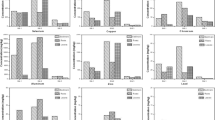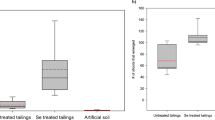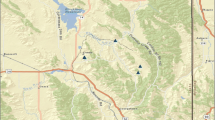Abstract
Selenium (Se) has long been known as an effective antagonist for counteracting mercury (Hg) and arsenic (As) toxicity in many animal and plant species. This study is the first to assess a low-dose Se additive as an in situ remediation tool for As- and Hg-contaminated gold mine tailing material. Mine tailing material from an 1860s gold mine stamp mill site was treated with different concentrations of sodium selenite (0, 0.5, 1, 3, 8, and 15 mg Se/kg). Reclamation grass seeds planted in each treatment showed significantly decreased plant toxicity with increasing [Se], as measured by increases in biomass, % emergence, and root lengths. Leachate was collected from each pot after the grass was harvested. The lowest Hg and As concentrations measured in the leachate were associated with the 1 mg Se/kg treatment (94 and 71 % lower than concentrations in leachate from untreated tailing material) and increased with lower and higher Se treatments. Finally, earthworms (Eisenia andrei) were introduced to the experimental treatments. Earthworm [Hg] decreased with increasing [Se], but this effect was confounded by differing [Hg] in the tailing material. Earthworm [As] decreased with [Se] up to 3 mg Se/kg, then earthworm [As] increased with tailing [Se]. This experiment confirms that low-dose selenium additions (up to 3 mg Se/kg tailing material) can have beneficial effects by limiting toxicity and mobility of As and Hg from the tailing material for both grass and earthworms.






Similar content being viewed by others
References
Aborde, F. (2013). Selenium and arsenic speciation in plants, Ph.D., University of Aberdeen.
Afton, S. E., Catron, B., & Caruso, J. A. (2009). Elucidating the selenium and arsenic metabolic pathways following exposure to the non-hyperaccumulating Chlorophytum comosum, spider plant. Journal of Experimental Botany, 60, 1289–1297.
Beatty, J.M. and Russo, G.A. (2014). Amient Water Qulity Guidelines for Selenium—Technical Report Update, in Water Protection and Sustainability Branch Environmental Sustainability and Strategic Policy Divivsion - British Columbia Ministry of Environment (ed.).
Belzile, N., Chen, Y.-W., Gunn, J. M., Tong, J., Alarie, Y., Delonchamp, T., & Lang, C.-Y. (2006). The effect of selenium on mercury assimilation by freshwater organisms. Canadian Journal of Fisheries and Aquatic Sciences, 63, 1–10.
Biester, H., & Zimmer, H. (1998). Solubility and changes of mercury binding forms in contaminated soils after immobilization treatment. Environmental Science & Technology, 32, 2755–2762.
Bluemlein, K., Klimm, E., Raab, A., & Feldmann, J. (2009). Selenite enhances arsenate toxicity in Thunbergia alata. Environmental Chemistry, 6, 486–494.
Burger, J., & Gochfeld, M. (2013). Selenium/mercury molar ratios in freshwater, marine, and commercial fish from the USA: variation, risk, and health management. Reviews on Environmental Health, 28, 129–143.
CCME. (2009). Canadian Soil Quality Guidelines: Selenium. Environmental and Human Health. Scientific Supporting Document., in Canadian Council of Ministers of the Environment (ed.), Winnipeg.
Charles, E., Thomas, D., Dewey, D., Davey, M., Ngallaba, S., & Konje, E. (2013). A cross-sectional survey on knowledge and perceptions of health risks associated with arsenic and mercury contamination from artisanal gold mining in Tanzania. BMC Public Health, 13, 74.
Chen, Y., Hall, M., Graziano, J. H., Slavkovich, V., van Geen, A., Parvez, F., & Ahsan, H. (2007). A prospective study of blood selenium levels and the risk of arsenic-related premalignant skin lesions. Cancer Epidemiology, Biomarkers & Prevention, 16, 207–213.
Dale, J.M. and Freedman, B. (1982). Arsenic pollution associated with tailings at an Abandoned Gold Mine in Halifax County, Nova Scotia, Proc. N.S. Inst. Sci. 32, 337–349.
Canada, E. (2004). Biological test method: tests for toxicity of contaminated soil to earthworms (Eisenia andrei, Eisenia fetida or Lumbricus terrestris), method development and applications section. Ottawa, Ontario: Environmental Technology Centre.
Environment Canada. (2012). Soil pH measurements, ecotoxicology and Wildlife Health Division. Biological Assessment and Standardization Section.
Environment Canada. (2013a). Determination of soil moisture content, eotoxicology and Wildlife Health Division. Biological Assessment and Standardization Section.
Environment Canada. (2013b). Formulation of artificial soil, ecotoxicology and Wildlife Health Division. Biological Assessment and Standardization Section.
Environment Canada. (2014). Determination of soil water holding capacity, ecotoxicology and Wildlife Health Division. Biological Assessment and Standardization Section.
Fischer, E., & Koszorus, L. (1992). Sublethal effects, accumulation capacities and elimination rates of As, Hg and Se in manure worm Eisenia fetida (Oligocaeta, Lumbricidae). Pedobiologia, 36, 172–178.
Gailer, J. (2002). Review: reactive selenium metabolites as targets of toxic metals/metalloids in mammals: a molecular toxicological perspective. Applied Organometallic Chemistry, 16, 701–707.
Gailer, J. (2007). Arsenic-selenium and mercury-selenium bonds in biology. Coordination Chemistry Reviews, 251, 234–254.
Hale, J. B., Watson, M. A., & Hull, R. (1946). Some causes of chlorosis and necrosis of sugar-beet foliage. Annals of Applied Biology, 33, 13–28.
Hamilton, S. J. (2004). Review of selenium toxicity in the aquatic food chain. The Science of the Total Environment, 326, 1–31.
Hartikainen, H., Xue, T., & Piironen, V. (2000). Selenium as an anti-oxidant and pro-oxidant in ryegrass. Plant and Soil, 225, 193–200.
Health Canada. (2014). Guidelines for Canadian Drinking Water Quality—Guideline Technical Document—Selenium, in H.E.a.C.S.B. Water and Air Quality Bureau (ed.), Ottawa, Ontario.
Hube, D. and Merly, C. (2013). Remediation of mercury contaminated sites: state of the Art and Recommendations for Future Needs., IMaHg Final Workshop.
Hultberg, H. (2002). Treatment of lakes and storage reservoirs with very low dosages of selenium to reduce methyl mercury in fish, IVL Swedish Environmental Research Institute.
Koch, I., McPherson, K., Smith, P., Easton, L., Doe, K. G., & Reimer, K. J. (2007). Arsenic bioaccessibility and speciation in clams and seaweed from a contaminated marine environment. Marine Pollution Bulletin, 54, 586–594.
Kumar, N., Mallick, S., Yadava, R. N., Singh, A. P., & Sinha, S. (2013). Co-application of selenite and phosphate reduces arsenite uptake in hydroponically grown rice seedlings: toxicity and defence mechanism. Ecotoxicology and Environmental Safety, 91, 171–179.
Langdon, C. J., Piearce, T. G., Meharg, A. A., & Semple, K. T. (2003). Interactions between earthworms and arsenic in the soil environment: a review. Environmental Pollution (Amsterdam, Netherlands), 124, 361–373.
Li, L., Wu, G., Sun, J., Li, B., Li, Y., Chen, C., Chai, Z., Iida, A., & Gao, Y. (2008). Detection of mercury-, arsenic-, and selenium-containing proteins in fish liver from a mercury polluted area of Guizhou Province China. Journal of Toxicology and Environmental Health. Part A, 71, 1266–1269.
Lock, K., & Janssen, C. (2001). Ecotoxicity of mercury to Eisenia fetida. Enchytraeus albidus and Folsomia candida. Biology and Fertility of Soils, 34, 219–221.
Ma, L., Zhong, H., & Wu, Y. G. (2015). Effects of metal-soil contact time on the extraction of mercury from soils. Bulletin of Environmental Contamination and Toxicology, 94, 399–406.
Malik, J. A., Goel, S., Kaur, N., Sharma, S., Singh, I., & Nayyar, H. (2012). Selenium antagonises the toxic effects of arsenic on mungbean (Phaseolus aureus Roxb.) plants by restricting its uptake and enhancing the antioxidative and detoxification mechanisms. Environmental and Experimental Botany, 77, 242–248.
Martin, T. A., & Ruby, M. V. (2003). In situ remediation of arsenic in contaminated soils. Remediation Journal, 14, 21–32.
Meunier, L., Koch, I., & Reimer, K. J. (2011). Effects of organic matter and ageing on the bioaccessibility of arsenic. Environmental Pollution (Amsterdam, Netherlands), 159, 2530–2536.
Moreno-Jimenez, E., Clemente, R., Mestrot, A., & Meharg, A. A. (2013). Arsenic and selenium mobilisation from organic matter treated mine spoil with and without inorganic fertilisation. Environmental Pollution, 173, 238–244.
Moriarty, M. M., Koch, I., Gordon, R. A., & Reimer, K. J. (2009). Arsenic speciation of terrestrial invertebrates. Environmental Science & Technology, 43, 4818–4823.
National Research Council. (1999). Committee on Technologies for Cleanup of Subsurface Contaminants in the DOE Weapons Complex.
Parízek, J., & Ostádalová, I. (1967). The protective effect of small amounts of selenite in sublimate intoxication. Experientia, 23, 142–143.
Parkman, H. and Hultberg, H. (2002). Occurrence and effects of selenium in the environment—a literature review, in I.-S.E.R. Institute (ed.).
Parsons, M.B. (2007). Reducing risks from metals: environmental impacts of historical gold mines. NRCan making a difference 001.
Parsons, M.B., Leblanc, K.W.G., Hall, G.E.M., Sangster, A.L., Vaive, J.E. and Pelchat, P. (2012). Environmental geochemistry of tailings, sediments, and surface waters collected from 14 historical gold mining districts in Nova Scotia, in G.S.o. Canada (ed.).
Raymond, L. (2010). International Symposium on Selenium Mercury Interactions - Session Summary from the SETAC North America 2010 Annual Meeting, SETAC North America 2010 Annual meeting.
Raymond, L. and Ralston, N. (2004). Mercury:selenium interactions and health implications. SMDJ Seychelles Medical and Dental Journal 7.
Reash, R. J. (2012). Selenium, arsenic, and mercury in fish inhabiting a fly ash exposure gradient: interspecific bioaccumulation patterns and elemental associations. Environmental Toxicology and Chemistry, 31, 739–747.
Rowe, R. K., & Hosney, M. S. (2013). Laboratory investigation of GCL performance for covering arsenic contaminated mine wastes. Geotextiles and Geomembranes, 39, 63–77.
Shaibur, M. R., Kitajima, N., Sugawara, R., Kondo, T., Huq, S. M. I., & Kawai, S. (2006). Physiological and mineralogical properties of arsenic-induced chlorosis in rice seedlings grown hydroponically. Soil Science and Plant Nutrition, 52, 691–700.
Singh, M., & Singh, N. (1978). Selenium toxicity in plants and its detoxification by phosphorus. Soil Science, 126, 255–262.
Somogyi, Z., Kiss, I., Kadar, I., & Bakonyi, G. (2007). Toxicity of selenate and selenite to the potworm Enchytraeus albidus (Annelida: Enchytraeidae): a laboratory test. Ecotoxicology, 16, 379–384.
Telmer, K.H. and Veiga, M.M. (2009). World emissions of mercury from artisanal and small scale gold mining, in N. Pirrone and R. Mason (eds.), Mercury Fate and Transport in the Global Atmosphere.
United Nations Environmental Programme (UNEP). (2013). Global mercury assessment 2013. Emissions, Releases and Environmental Transport: Sources.
United States Environmental Protection Agency. (1998). Method - 7473 Mercury in solids and solutions by thermal decomposition, amalgamation, and atomic absorption spectrophotometry. District of Columbia: Washington.
Vazquez, S., Moreno, E., & Carpena, R. O. (2008). Bioavailability of metals and As from acidified multicontaminated soils: use of white lupin to validate several extraction methods. Environmental Geochemistry and Health, 30, 193–198.
Walker, S. R., Parsons, M. B., Jamieson, H. E., & Lanzirotti, A. (2009). Arsenic mineralogy of near-surface tailings and soils: influences on arsenic mineralogy and bioaccessibility in the Nova Scotia gold mining districts. Canadian Mineralogist, 47, 533–556.
Wang, X., Tam, N. Y.-F., Fu, S., Ametkhan, A., Ouyang, Y., & Ye, Z. (2014). Selenium addition alters mercury uptake, bioavailability in the rhizosphere and root anatomy of rice (Oryza sativa). Annals of Botany.
Wang, Y., Dang, F., Evans, R., Zhong, H., Zhao, J., & Zhou, D. (2016). Mechanistic understanding of MeHg-Se antagonism in soil-rice systems: the key role of antagonism in soil. Scientific Reports, 6.
Welfringer, B., & Zagury, G. J. (2009). Evaluation of two in vitro protocols for determination of mercury bioaccessibility: influence of mercury fractionation and soil properties. Journal of Environmental Quality, 38, 2237–2244.
Winch, S., Fortin, D., Lean, D. R. S., & Parsons, M. (2008). Factors affecting methylmercury levels in surficial tailings from historical Nova Scotia Gold Mines. Geomicrobiology Journal, 25, 112–129.
Zagury, G. J., Neculita, C. M., Bastien, C., & Deschenes, L. (2006). Mercury fractionation, bioavailability, and ecotoxicity in highly contaminated soils from chlor-alkali plants. Environmental Toxicology & Chemistry, 25, 1138–1147.
Zeng, H., Uthus, E. O., & Combs, G. F., Jr. (2005). Mechanistic aspects of the interaction between selenium and arsenic. Journal of Inorganic Biochemistry, 99, 1269–1274.
Zhang, H., Feng, X., Zhu, J., Sapkota, A., Meng, B., Yao, H., Qin, H., & Larssen, T. (2012). Selenium in soil inhibits mercury uptake and translocation in rice (Oryza sativa L.). Environmental Science & Technology, 46, 10040–10046.
Acknowledgments
This project was supported by a Natural Sciences and Engineering Research Council of Canada (NSERC) Engage Grant (EGP 477580–14), an NSERC Discovery Grant (RGPIN/311786 2012–2017) and a SMUworks Summer Student stipend funding to Dr. Linda Campbell. The authors thank David Parkinson and Chris Elliot with Amec Foster Wheeler, Environment and Infrastructure for help and support as well as Dr. Michael Parsons, Natural Resources Canada, for field support and information.
Author information
Authors and Affiliations
Corresponding author
Ethics declarations
Conflict of Interest
No conflicts of interest are declared for this project.
Electronic supplementary material
Below is the link to the electronic supplementary material.
ESM 1
(PDF 313 kb)
Rights and permissions
About this article
Cite this article
Chapman, E.E.V., Robinson, J., Berry, J. et al. Can a Low-Dose Selenium (Se) Additive Reduce Environmental Risks of Mercury (Hg) and Arsenic (As) in Old Gold Mine Tailings?. Water Air Soil Pollut 227, 216 (2016). https://doi.org/10.1007/s11270-016-2909-9
Received:
Accepted:
Published:
DOI: https://doi.org/10.1007/s11270-016-2909-9




